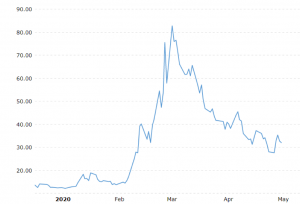Nobel laureate and University of Chicago finance professor Gene Fama
The market continues to process information and assign value to investments. This is exactly what markets should do, but it’s much more challenging when we’re in the midst of a global crisis.
While we might like to think that the market is rational, the volatility of the markets over the past few months could lead one to believe that investors are manic.
The VIX is one way to assess the volatility of the markets. The Chicago Board Options Exchange (CBOE) created the VIX in the early 1990s. It is derived from the prices of options on the S&P 500 Index. Because the S&P 500 Index is fairly representative of the US stock market, the VIX offers an assessment of the level of fear among investors. Below is a chart of the VIX from the start of the year.

Source: https://www.macrotrends.net/2603/vix-volatility-index-historical-chart
We can see that investors became increasingly anxious as news of the novel coronavirus emerged. The VIX is often called “the fear index,” because it gauges the worry that investors have about the economy and the stock market.
As extreme as this spike might seem, the VIX actually hit higher levels in October 2008 during the Great Recession. For perspective, the VIX has hovered between 10 and 30 for the last three decades.
The Markets
The Dow Jones Industrial Average was up 911 points, or 3.85%, on Monday. The S&P 500 Index rose 90 points, or 3.15%. Yesterday, the Dow was down 391 points, or 1.59%. The S&P 500 Index fell 31 points, or 1.0%.
Explaining Market Gyrations – A Two Day Sample
So, why, you ask, was the market up over 3% on Monday? The answer: Good news.
On Monday, investors learned that the Federal Reserve remains capable of providing more support for the economy. Fed Chairman Jay Powell indicated during testimony before a Congressional panel that the central bank will use its “full range of tools to support the economy.” The Fed has already provided trillions of dollars to soften the impact of the novel coronavirus. But investors sense more may be needed. Powell said, “We are not out of ammunition by a long shot.” Good news for investors.
We also learned that pharmaceutical company Moderna has produced a vaccine for COVID-19 that has shown promise in early-stage human trials. The Cambridge, Massachusetts-based company will move to a large-scale clinical trial in July. If that goes well, it’s possible that the Food & Drug Administration may approve emergency use of the vaccine in the fall. A vaccine would be a complete game-changer and the market reacted positively to the hopeful news.
States are beginning to relax their measures to prevent the spread of the virus. This will pull industries out of hibernation and enable companies to resume operations. Business have to operate to generate earnings. Investors values companies based on their earnings. So, the resumption of activity is additional good news for the market
So, what happened on Tuesday? The answer: News that wasn’t so good.
Chairman Powell and Treasury Secretary Mnuchin both testified before the Senate Banking Committee. Their testimony was reassuring, but not enough to prevent the market from dropping on other news. That other significant news was that Moderna’s report about its vaccine candidate lacked sufficient data. So, the foundation for the market’s jump on Monday was undercut a day later and investors reacted accordingly.
Investors got more cold water poured on them when Boston Federal Reserve President Eric Rosengren cautioned, during an interview on CNBC, that much of the economy depends on stopping community spread of the novel coronavirus. He pointed out that more than 20% of American jobs are in the retail, hotel, airline and restaurant industries. If people, particularly older people with more discretionary income, are not comfortable entering malls, staying in hotels, flying on planes, and dining in restaurants, the economy won’t recover to its pre-virus levels. He also cautioned that if the country opens too rapidly, we run the risk of a second wave of infections and the economy will be worse off. He said that government officials should let the data direct the speed at which they re-open. We have heard this numerous times from Dr. Anthony Fauci, a key member of the White House Coronavirus Task Force. The virus, he has said, determines what happens and when, not politicians.
We discourage clients, friends and colleagues from following the market on a daily basis. It’s not the best use of your valuable time. It’s also not good for your mental and emotional health. But we thought we would take the past few days to explain how investors “price in” information. This process is rapid and efficient. It is precisely how robust markets work.
COVID-19 Numbers
Globally, across 187 countries, there have been over 4.9 million confirmed cases and over 323,000 deaths. In the US, over 1.5 million have been infected and nearly 92,000 have perished.
Gratitude
We will wrap up our writing today with three more things for which we are grateful:
- People who make masks and donate them. (Thank you Nicolien!)
- Delivery drivers who bring us food, home supplies and our Amazon purchases.
- Nursing home and VA facility workers, who are caring for the most vulnerable among us.
Keep the faith, be safe and stay healthy.
PLEASE SEE important disclosure information at www.springwaterwealth.com/blog-disclosure/.
